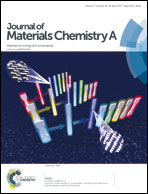Nitrogen and sulfur co-doped porous carbon derived from human hair as highly efficient metal-free electrocatalysts for hydrogen evolution reactions†
Abstract
Design and engineering of low-cost and high-efficiency electrocatalysts for hydrogen evolution reactions (HER) has attracted increasing interest in renewable energy research. Herein, a highly active and stable metal-free electrocatalyst, N and S co-doped porous carbon derived from human hair, was developed for HER for the first time, with an electrocatalytic performance comparable to that of state-of-the-art commercial 20 wt% Pt/C catalysts. SEM, TEM and nitrogen adsorption–desorption measurements showed that the resultant carbon exhibited a porous structure with a high specific surface area (up to 830.0 m2 g−1) and rich porosity. XPS measurements showed that N and S were co-doped into the carbon molecular skeletons. Importantly, electrochemical measurements showed high activity for hydrogen evolution with a low overpotential of only −12 mV, a Tafel slope of 57.4 mV dec−1, a current density of 10 mA cm−2 at −0.1 V vs. RHE, and remarkable durability. The results highlight a unique paradigm for the preparation of highly efficient electrocatalysts for HER based on abundant biowastes.


 Please wait while we load your content...
Please wait while we load your content...